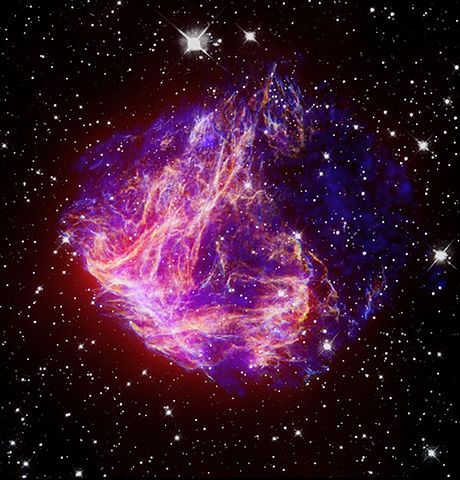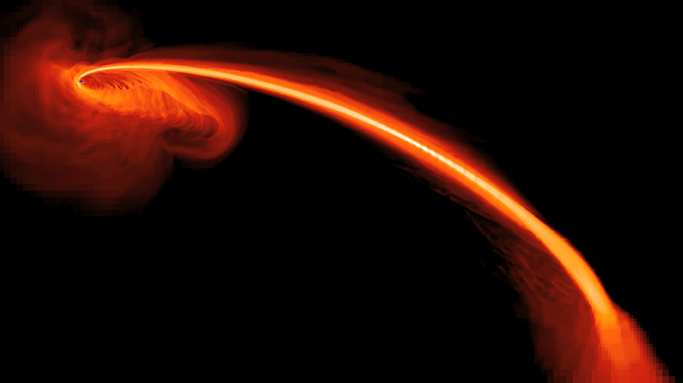Black holes may be among the strangest – and most commonly misunderstood – objects in our universe. The remnants of the most massive stars, they sit at the limit of our understanding of physics. They can contain several times the mass of our sun in a space no larger than a city. With gravity so intense that not even light can escape their surfaces, black holes can teach us about the absolute extremes in the cosmos and the very structure of space itself.

Conceptually, black holes aren’t all that complicated. They are nothing more than extremely dense cores of once-massive stars. Most stars, like our sun, end their lives peacefully by gently blowing their outer layers into space. But stars exceeding about eight times the mass of the sun take another, more dramatic, path.
These stars die when they can no longer fuse atomic nuclei in their core. It’s not that they run out of fuel, per se. Rather, once the star has a core of iron, fusing together atoms to make new elements actually costs the star energy. Lacking an energy source, the star can’t hold itself up against the relentless struggle with gravity. The outer layers of the star come crashing down.
As several octillion tons of gas come hurdling down, the star’s core undergoes a drastic change and becomes resilient to further compression. The infalling gas hits the now-hardened core and rebounds. The rapid gas compression sets off one last wave of uncontrolled nuclear fusion. The star, now wildly out of balance, explodes. The resulting supernova can outshine an entire galaxy and can be seen from across the universe.

In the supernova’s wake, the core remains. This dense soup of subatomic particles has a couple of options at this point. For a star with less mass than 20 suns, the core holds together as a neutron star. But for the real stellar heavyweights, the core transforms into a truly exotic object. A black hole is born.
Stars thrive in a precarious balance. Gravity wants to pull the star together, internal pressure wants to tear it apart. The most drastic changes happen when one of these forces gets the upper hand. Above a core mass of a few suns, there is no known source of pressure that can balance gravity. The stellar remnant collapses upon itself.
Squeezing all that mass into a smaller and smaller volume makes the gravity at the dead star’s surface skyrocket. Ratcheting up the gravity makes it increasingly difficult for anything to escape. Get the gravity high enough – about 30 thousand times what we feel here on Earth – and some truly bizarre side effects pop up.

Throw a ball up into the air, and eventually it stops, turns around, and comes back to your hand. Throw the ball harder, it goes higher – but still falls back down. Throw the ball hard enough and the ball can escape Earth’s gravity. That point-of-no-return is called the “escape velocity”. It’s different for every planet, star, and comet. Earth’s escape velocity is about 40,000 km/hr. For the sun, it’s over 2 million km/hr!. On a very small asteroid, jumping too high might accidentally launch you into orbit.
On a black hole, however, the escape velocity is greater than the speed of light!
Since nothing can go that fast, then nothing – not even light itself – can get up enough speed to escape a black hole’s surface. No type of radiation—radio waves, UV, infrared – can emanate from a black hole. No information at all can ever leave. The universe has drawn a curtain around whatever remains of these stellar behemoths and so we can’t directly study them. All we can do is conjecture.
The black hole itself is defined by a volume of space delineated by an “event horizon”. The event horizon invisibly marks off the boundary where the escape velocity is exactly equal to the speed of light. Outside of the horizon, your spaceship has at least a theoretical chance of making it home. Crossing that line sets you on a one-way journey to whatever sits inside.

What sits within the event horizon is a complete mystery. Is there still an object sitting in the center, some shadow of a once brilliant stellar core? Or does nothing stop the gravity from crushing the nuclei to a single point, possibly even puncturing the fabric of space-time? Our lack of understanding of such extreme environments and the veil of ignorance that cloaks these creatures gives the imagination room to run wild. Visions of tunnels to other dimensions, parallel universes, and even distant times are rampant. But the only honest answer to the question “what lies beyond the event horizon?” is a simple “we don’t know!”
The bottom line is that black holes are the burying grounds of extremely massive stars. Following a supernova explosion, the massive core is left behind. Lacking a suitable balancing force, gravity pulls the core together to a point where the escape velocity exceeds the speed of light. From this point on, no light – and no information of any kind – can radiate into space. All that remains is a perfectly black void where once a mighty star stood.











